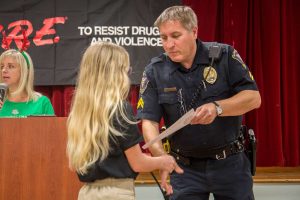21 The Failure of Reagan Era Drug Policy and D.A.R.E.
Anna Lipke
Historically, drug policy and education in the United States have not been rooted in scientific, evidence-based practice. Often, legislation is informed by stigma against drug users, while drug education programs are firmly rooted in abstinence ideals, which are overly simplistic and ineffective. These programs fail to consider environmental factors such as peer or familial drug use, community disconnectedness, or drug access (Kendler et al., 2008). The Reagan presidency signified an escalation of "tough on crime" drug policy and abstinence-based drug education programs (Platt, 1987).
Reagan Era Drug Policy
The anti-drug policy of the Reagan administration was marked by drastic increases in funding for police and imprisonment for drug possession (Wagner, 2018). Halfway through the Reagan presidency, federal spending on anti-drug efforts had tripled, totaling 3.9 billion dollars with the passage of the Anti-Drug Abuse Act of 1986 (Sharp, 1992). The focus of drug prevention and education was cultivated around the “Just Say No” phrase, attributed to Nancy Reagan, who in 1982, coined the phrase in response to a child asking what to do if they were offered drugs (The Ronald Reagan Presidential Foundation & Institute, n.d.). The “Just Say No” mentality inspired abstinence and resistance-based, anti-drug education programs such as S.M.A.R.T., D.A.R.E., and A.L.E.R.T. (Elliot, 1993).

“Nancy Reagan at a ‘Just Say No’ rally at the White House, May 22, 1986” by White House Photo Office is in the Public Domain
Anti-Drug Abuse Act of 1986
The Anti-Drug Abuse Act of 1986 was the Reagan Administration’s response to a national moral panic around crack cocaine. This legislation has contributed to exponential growth in mass incarceration. The Anti-Drug Abuse Act of 1986 was informed by unfounded beliefs such as crack cocaine is more addictive than powder cocaine or crack use could lead to psychosis and increase rates of violent crime (Vagins & McCurdy, 2006). Crack cocaine and powder cocaine are chemically identical and produce similar effects when used. The only difference is in the manner of consumption and the populations who have access to each substance (National Drug Policy Alliance, 2022). Over 80% of defendants convicted for crack-cocaine possession are African American, despite the fact that the population of crack users in the U.S. are majority (66%) White or Hispanic (Vagins & McCurdy, 2006). This is directly attributable to the main tenets of the Anti-Drug Abuse Act of 1986, which encouraged longer prison sentences, double standards in jail time, and policing that enforced racial stereotypes.
Central to this Anti-Drug Abuse Act of 1986 was the differentiation in punitive response for possession and distribution of crack cocaine versus to powder-cocaine, the establishment of mandatory minimums, asset seizures, and increased law enforcement funding (Britton, 2019). Mandatory minimums were created with the intent to deter crime with harsher penalties. However, longitudinal data indicates that crack cocaine use has not declined since its implementation in 1986 (Walker & Mezuk, 2018). Criminalization and “tough on crime” drug policy does not reduce substance use and abuse rates. Instead, it creates massive societal inequities; for example, mandatory minimums were disproportionately applied to nonviolent defendants of color at the bottom of the drug distribution hierarchy (Britton, 2019).
D.A.R.E.
D.A.R.E., an abstinence and resistance-based anti-drug education program, was developed by a collaboration between the Los Angeles Police Department and the L.A. Unified School District in 1983. D.A.R.E. is the only “Just Say No” drug education program delivered to students by uniformed police officers (Elliot, 1993). D.A.R.E. curriculum focuses on building students’ self-esteem and resistance skills to say no when offered drugs, and lectures are structured based on the social influence model of prevention.
Educational presentations are delivered by officers on the consequences of drug use, learning and recognizing marketing tactics around drugs, and peer pressure resistance modeling (National Research Council, 1993; Rosenbaum, 1998). Sessions occurred over seventeen weeks in fifth and sixth-grade classrooms (Ringwalt et al., 1994).

“Students with Charles F. Bolden Elementary School graduate” by Defense Visual Information Distribution Service is in the Public Domain
Despite minimal evidence supporting the program’s effectiveness, D.A.R.E. was the only educational program to receive federal funding from the Safe and Drug-Free Schools and Communities Act of 1986. One footnote required that 10% of state grants for reducing drug use must fund programs that include classroom instruction by uniformed law enforcement officials (Rosenbaum, 1998). The passing of this act caused D.A.R.E. to spread across the United States. Seven years later, D.A.R.E. was being administered to five million school children (Elliot, 1993). By 1998, D.A.R.E. programs were implemented nationally in over 70% of all public school districts, making it the most widespread drug prevention education program (Rosenbaum, 1998).
Despite D.A.R.E.’s presence in schools nationwide, there is overwhelming evidence that suggests that D.A.R.E. is ineffective at reducing actual drug use in student populations. At the same time, some studies even report a “boomerang effect”, meaning youth that received D.A.R.E. report higher lifetime drug use than students who did not receive D.A.R.E. (Rosenbaum, 1998). In 1994, the National Institute of Justice reported that D.A.R.E. was less effective than other prevention programs emphasizing social interaction (Ringwalt et al., 1994). The failure of D.A.R.E. may be attributable to the focus on fifth and sixth graders, a population that does not frequently engage in drug use and the lack of interactive learning activities. D.A.R.E. was repeatedly shown to have almost no impact on substance use, even in the short term, and D.A.R.E. students were indistinguishable from their non-D.A.R.E. controls in the long term (Gottfredson, 2016).
Impacts on the Present and Future:
Rather than concentrating time, effort, and resources on unproductive drug education programs, the focus should shift to methodologically-sound, evidence-based programs, such as the Youth in Iceland model. This model uses culturally appropriate methods to provide kids and parents with adequate education and support to live a healthy lifestyle. In Iceland, schools were kept open after hours to host afterschool clubs, and funding was increased for accessible extracurriculars, such as music, dance, and art classes, community parenting classes, and other institutional modifications. Consistent results showed that teen substance use rates of alcohol and cigarettes dropped significantly, which may indicate that more emphasis should be placed on improving social infrastructure rather than broad-sweeping, ineffective education programs (Young, 2017).
Conclusion
The Reagan presidency escalated “tough on crime” political culture and gave rise to resistance education programs like D.A.R.E. While prolific and well-funded, D.A.R.E. was ineffective at reducing youth substance use and abuse rates. Strengthening community infrastructure may prove to be a more effective method for preventing young people from using substances.
Review Questions
1. The D.A.R.E. program may have been ineffective due to _____.
a. Inappropriate target population (5th and 6th graders)
b. Lecture-based lessons with little interaction
c. Law enforcement agents were teaching lessons
d. All of the above
2. True or false: “tough on crime” policies reduce substance use and abuse rates.
a. True
b. False
3. The Anti-Drug Abuse Act of 1986 encourages _____.
a. Double standards in jail time
b. Racist policing practices
c. Longer prison sentences
d. All of the above
References
Britton, T. (2019, April). Does Locked Up Mean Locked Out? The Effects of the Anti-Drug Act of 1986 on Black Male Students’ College Enrollment. Institute for Research on Labor and Employment. https://irle.berkeley.edu/files/2019/04/Does-Locked-Up-Mean-Locked-Out.pdf
D.A.R.E. America. (n.d.).About D.A.R.E. https://dare.org/about/
Elliott, J. (1993, May). Just say nonsense. Washington Monthly, 25(5), 18+. https://link-gale-com.libproxy.clemson.edu/apps/doc/A13786316/AONE?u=clemsonu_main&sid=bookmark-AONE&xid=6f0966a7
Garland, D. W. (Ed.). (2001). Mass imprisonment : Social causes and consequences. SAGE Publications, Limited.
Gottfredson, D. C. (2016). Why registries matter. Criminology & Public Policy, 15(3), 651–659. https://doi.org/10.1111/1745-9133.12219
Kendler, K. S., Schmitt, E., Aggen, S. H., & Prescott, C. A. (2008). Genetic and environmental influences on alcohol, caffeine, cannabis, and nicotine use from early adolescence to middle adulthood. Archives of General Psychiatry, 65(6), 674–682. https://doi.org/10.1001/archpsyc.65.6.674
National Drug Policy Alliance. (2022). What is the difference between cocaine and crack? https://drugpolicy.org/drug-facts/cocaine/difference-crack
National Research Council (US) Committee on Substance Abuse Prevention Research. (1993). Concepts of Prevention. In Gerstein D.R., Green L.W. (Eds). Preventing drug abuse: What do we know? Washington (DC): National Academies Press. https://www.ncbi.nlm.nih.gov/books/NBK234581/
Palamar, J. J., Davies, S., Ompad, D. C., Cleland, C. M., & Weitzman, M. (2015). Powder cocaine and crack use in the United States: An examination of risk for arrest and socioeconomic disparities in use. Drug and Alcohol Dependence, 149, 108-116. https://doi.org/10.1016/j.drugalcdep.2015.01.029
Platt, T. (1987). U.S. criminal justice in the Reagan era: An assessment. Crime and Social Justice, 29, 58–69. http://www.jstor.org/stable/29766345
Ringwalt, C. L., Greene, J. M., Ennett, S. T., Iaehan, R., Clayton, R. R., & Leukefeld, C. G. (1994, Sept). Past and Future Directions of The D.A.R.E.® program: An evaluation review. U.S. Department of Justice. https://www.ojp.gov/pdffiles1/Digitization/152055NCJRS.pdf
Rosenbaum, D. & Hanson, G.S. (1998). Assessing the effects of school-based drug education: a six-year multilevel analysis of project D.A.R.E. Journal of Research in Crime and Delinquency, 35(4), 381–412. https://doi.org/10.1177/0022427898035004002
Sharp, E. B. (1992). Agenda-setting and policy results: lessons from three drug policy episodes. Policy Studies Journal, 20(4), 538–551. https://doi.org/10.1111/j.1541-0072.1992.tb00182.x
Stone-Mediatore, S. (n.d.). Tough questions for tough-on-crime policies. Ohio Wesleyan University. https://www.owu.edu/news-media/from-our-perspective/tough-questions-for-tough-on-crime-policies/
The Ronald Reagan Presidential Foundation & Institute. (n.d.). Her causes: Just Say No. https://www.reaganfoundation.org/ronald-reagan/nancy-reagan/her-causes/
The United States Department of Justice. (2022, February 17). Types of federal forfeiture. https://www.justice.gov/afms/types-federal-forfeiture
Wagner, A.J. (2018). A Secret Police: The Lasting Impact of the 1986 FOIA Amendments. Communication Law and Policy, 23(4), 387–426. https://doi.org/10.1080/10811680.2018.1516441
Walker, L. S., & Mezuk, B. (2018). Mandatory minimum sentencing policies and cocaine use in the U.S., 1985-2013. BMC International Health and Human Rights, 18(1). 1-10. https://doi.org/10.1186/s12914-018-0182-2
Vagins, D., &; McCurdy, J. (2006, October). Cracks in the system: 20 years of the unjust federal crack cocaine law. American Civil Liberties Union. https://www.aclu.org/other/cracks-system-20-years-unjust-federal-crack-cocaine-law
Vanderbilt Peabody College. (n.d.). What is an evidence-based practice or program (EBP)? IRIS Center. https://iris.peabody.vanderbilt.edu/module/ebp_01/cresource/q1/p01/
Young, E. (2017, January 19). How Iceland got teens to say no to drugs. The Atlantic. https://www.theatlantic.com/health/archive/2017/01/teens-drugs-iceland/513668/
Evidence-based practices or programs are proven to be effective by a rigorous body of research (Allen, What is an evidence-based practice or Program?).
the practice of not doing or having something that is wanted or enjoyable
“Tough-on-crime” policy is comprised of increased prison sentences, rigid penal codes, promotion of police search and seizures, strict parole boards, and policies that makes challenging wrongful convictions difficult.
(Stone-Mediatore, Tough questions for tough-on-crime policies)
the inherent ability of an organism to resist harmful influences
Mass incarceration can be defined as historically unprecedented rates of incarceration and high prison populations compared to external, similar societies. The escalation from individual incarceration to "systemic imprisonment of whole groups of the population" is a defining feature of mass incarceration (Garland, 2001).
a serious mental condition in which a person's connection to reality is lost
inflicting, involving, or aiming at punishment
Asset seizures or forfeitures were "designed to deprive criminals of the proceeds of their crimes" and disenfranchise criminal enterprises (The United States Department of Justice, 2022).
Mandatory minimum sentences enforce the minimum imprisonment penalty for those convicted of specific offenses such as drug-related offenses or identity theft (United States Courts, 2017).
involving the repeated observation or examination of a set of subjects over time with respect to one or more study variables
Drug Abuse Resistance Education (About D.A.R.E. 2023)
The social influence model of prevention focuses on educating students on the negative health outcomes of a dangerous behavior. Students receive education on how to recognize and resist social influences such as peer pressure to engage in dangerous behaviors (National Research Council, 1993).

